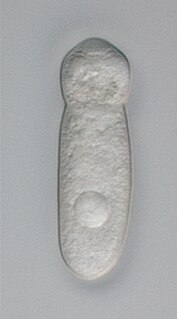A mucron is an attachment organelle found in archigregarines - an order of epicellular parasitic Conoidasida. [1] [2]
In cell biology, an organelle is a specialized subunit within a cell that has a specific function. Organelles are either separately enclosed within their own lipid bilayers or are spatially distinct functional units without a surrounding lipid bilayer.
The Archigregarinorida are an order of parasitic alveolates in the phylum Apicomplexa. Species in this order infect marine invertebrates — usually annelids, ascidians, hemichordates and sipunculids.

Conoidasida is a class of parasitic alveolates in the phylum Apicomplexa. The class was defined in 1988 by Levine and contains two subclasses – the coccidia and the gregarines. All members of this class have a complete, hollow, truncated conoid. Gregarines tend to parasitize invertebrates with the mature gamonts being extracellular, the coccidia mostly infect vertebrates and have intracellular gamonts.
The mucron is derived from the apical complex, which is found in all members of the phylum Apicomplexa. [1] [3]
In biology, a phylum is a level of classification or taxonomic rank below kingdom and above class. Traditionally, in botany the term division has been used instead of phylum, although the International Code of Nomenclature for algae, fungi, and plants accepts the terms as equivalent. Depending on definitions, the animal kingdom Animalia or Metazoa contains approximately 35 phyla, the plant kingdom Plantae contains about 14, and the fungus kingdom Fungi contains about 8 phyla. Current research in phylogenetics is uncovering the relationships between phyla, which are contained in larger clades, like Ecdysozoa and Embryophyta.

The Apicomplexa are a large phylum of parasitic alveolates. Most of them possess a unique form of organelle that comprises a type of plastid called an apicoplast, and an apical complex structure. The organelle is an adaptation that the apicomplexan applies in penetration of a host cell.
The mucron is located at the anterior (apical) end of the cell and comprises the conoid, rhoptries, apical polar ring(s), and a large food vacuole (also called mucronal vacuole) having an outlet opening - a cytostome. It is used to attach and to feed from the host's cell. [4] [5] [6]

A vacuole is a membrane-bound organelle which is present in all plant and fungal cells and some protist, animal and bacterial cells. Vacuoles are essentially enclosed compartments which are filled with water containing inorganic and organic molecules including enzymes in solution, though in certain cases they may contain solids which have been engulfed. Vacuoles are formed by the fusion of multiple membrane vesicles and are effectively just larger forms of these. The organelle has no basic shape or size; its structure varies according to the requirements of the cell.

A cytostome or cell mouth is a part of a cell specialized for phagocytosis, usually in the form of a microtubule-supported funnel or groove. Food is directed into the cytostome, and sealed into vacuoles. Only certain groups of protozoa, such as the ciliates and excavates, have cytostomes. An example is Balantidium coli, a ciliate. In other protozoa, and in cells from multicellular organisms, phagocytosis takes place at any point on the cell or feeding takes place by absorption.
The epimerites of some aseptate eugregarines superficially (at the light microscopic level) resemble mucron and are usually called in the same way. [1] [3] [2] This widespread misunderstanding originated from the conventional definition first proposed by Levine in 1971: "[the mucron is] an attachment organelle of aseptate gregarines. It is similar to an epimerite, but is not set off from the rest of the gregarine body by what appears under the light microscope to be a septum" [7] : thus, it may be equally applied to archigregarines and aseptate eugregarines as both they are aseptate. Note that the genuine epimerites are usually not sparated by septa from the rest of the cell, [8] [9] so this definition is actually misleading. [2]
The Eugregarinorida are the most large and diverse order of gregarines — parasitic protists belonging to the phylum Apicomplexa. Eugregarines are found in marine, freshwater and terrestrial habitats. These species possess large trophozoites that are significantly different in morphology and behavior from the sporozoites. This taxon contains most of the known gregarine species.




